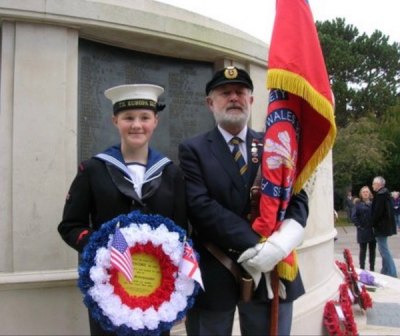Bedfordshire Crew Honored in U.K.
3,855 miles from Ocracoke Island is Lowestoft, a city developed on the eastern-most part of England. Lowestoft is home to the Royal Navy Patrol Service monument in Belle Vue Park. On October 7, 2017, during the annual parade and memorial ceremony, a wreath was placed to honor the 32 sailors of HMT Bedfordshire whose bodies were never recovered. The wreath identified Ocracoke, making even more solid the connection this island has with the men who served on the Bedfordshire, their families, and the Royal Navy Patrol Service.
Beginning in August of 1939, the Royal Navy Reserve – part of the British Royal Navy – was mobilized and the city became home to the Royal Navy Patrol Service (R.N.P.S.). During the First World War, the use of small vessels became very beneficial to use for mine sweeping, so as World War II began, the British Royal Navy called on citizens to allow their vessels to be converted to perform mine sweeping missions and be equipped with anti-aircraft and anti-submarine weaponry. Some of the men who volunteered themselves and their vessels were fishermen, while others worked jobs much like those of us who live on Ocracoke: shop keepers, business owners, mailmen, and educators.
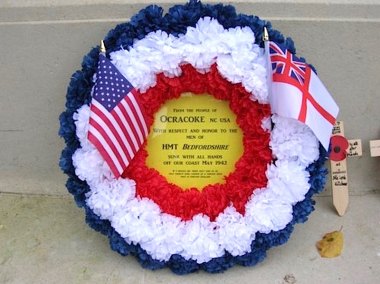
The Royal Navy quickly took over Lowestoft by establishing five separate naval facilities. R.N.P.S Headquarters were located at a base called HMS Europa, but the men who volunteered to serve were sent all over the world to conduct mine sweeping and anti-submarine missions. Crews patrolled the Atlantic and Arctic Oceans, the Mediterranean Sea, and into the Far East, but they were most well known for keeping the waters between Britain and the European Continent clear and open as Germany tried to cut off supplies going to and from Great Britain.
Before the U.S. entered the War, Britain stood alone against Germany. President Roosevelt and British Prime Minister Winston Churchill signed two agreements: the Destroyers for Bases Agreement and the Lend-Lease Act. Desperate for aid, Churchill agreed to both, though reluctantly so, due to the horrible condition of the ships and the long-lasting debt now placed on Britain due to the Lend-Lease Act. (Read more in our article from April 2017, Ocracoke & the Battle of the Atlantic.)
After the Japanese devastated the United States Navy base at Pearl Harbor on December 7, 1941, the U.S. finally joined the war effort in the Pacific and in Europe. German u-boats had been sinking ships off the East Coast since the war began, but now will hostilities officially declared between Germany and U.S. and with the U.S. Navy being severely disabled, Roosevelt appealed to Churchill for help.
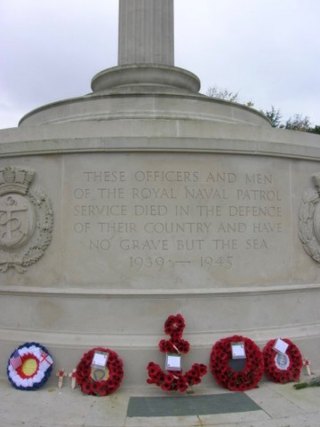
Beginning in March of 1942, 24 Royal Navy Patrol Service vessels were dispatched to the East Coast of the United States. These vessels were still responsible for mine sweeping and anti-submarine missions, but also took on the role of escorting merchant vessels, assisting in rescue missions, acting as lookouts for U.S. Navy operations, and protecting the East Coast from German invasion. One of the vessels sent to the East Coast from Lowestoft was HMT Bedfordshire (pronounced Bed-ford-sure). Once the Admiralty took control of the fishing trawler and she was converted to an anti-aircraft/submarine vessel, she was send to Morehead City, NC with another converted vessel the HMT St. Loman.
In the early morning hours of May 11, 1942, the two trawlers found u-558 off the coast of Cape Lookout, NC. The St. Loman was able to evade torpedo strikes, but the Bedfordshire was struck twice, causing the vessel to sink almost immediately, killing all 37 sailors. In the days following the sinking, the bodies of four sailors believed to be from the Bedfordshire washed ashore on Ocracoke and a fifth washed onto Hatteras Island. The people of Ocracoke buried the four sailors within the village, where they have remained since 1942.
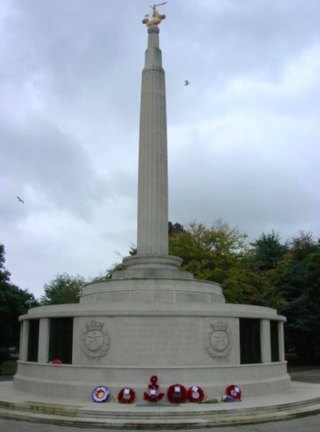
In 1975, surviving sailors of the Royal Navy Patrol Service founded an Association to preserve the history and remember the sailors who fought from 1939-1946. Where HMS Europa once was are now a monument and museum.
The monument lists the names of sailors who have no known graves and is maintained by the Commonwealth War Graves Commission. October of 1976 marked the first service held at the memorial to commemorate the sailors of the Royal Navy Patrol Service, and that tradition continues to this day.
To become a member of the Royal Navy Patrol Service Association or to read more about the organization and its history, visit www.rnpsa.co.uk
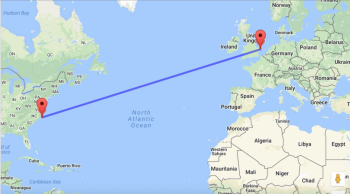
The grounds of the British Cemetery on Ocracoke is leased (in perpetuity) to Great Britain and as of May 2017 is maintained by the Commonwealth. The annual ceremony on Ocracoke will next be observed on May 11. 2018.
